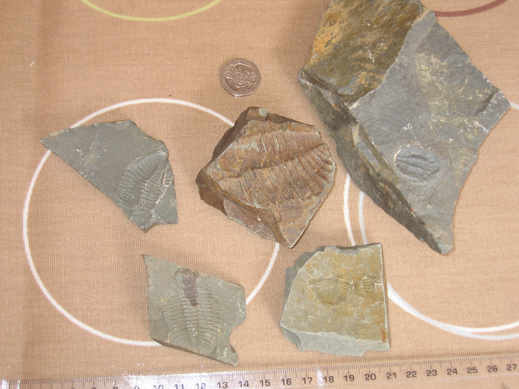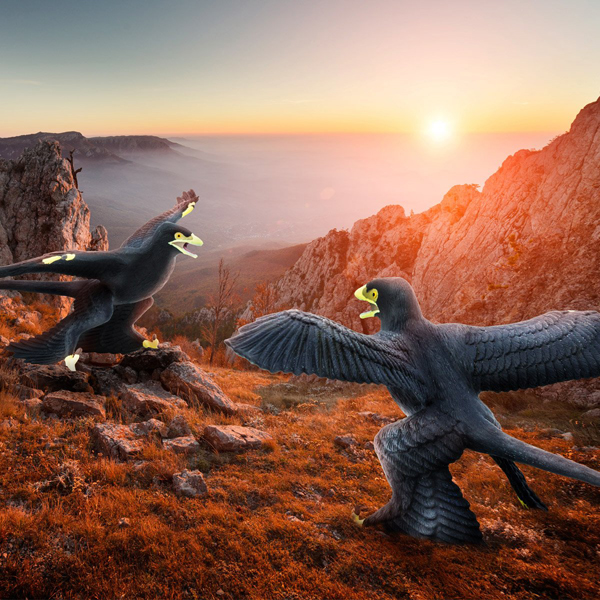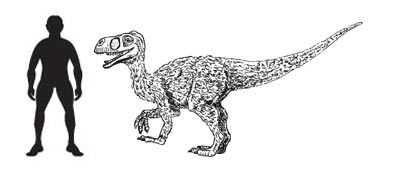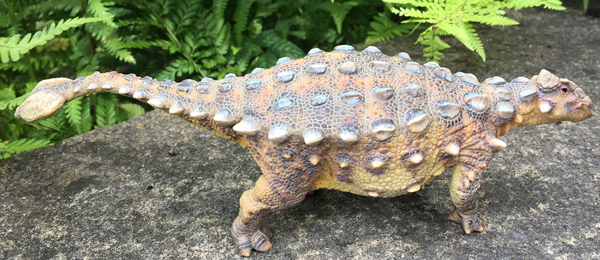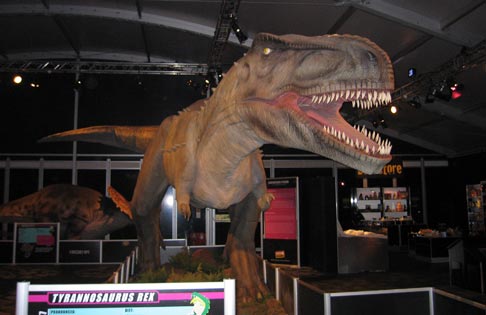New Spinosaurus from South America Described – A Rival to T. rex
A team of scientists have just published a scientific description of a new genus of giant spinosaurid dinosaur, perhaps one that rivalled Tyrannosaurus rex in terms of its size. The palaeontologists have provided a fascinating insight into the ancient Cretaceous ecosystem of Brazil, one that may have been dominated by this giant predator.
Giant Spinosaurid Dinosaur
The spinosaurids have only really come to the attention of the wider public, thanks to the appearance of a giant Spinosaurus in the film – Jurassic Park III, a movie which required a new angle on the Tyrannosaurus rex being the big baddie, as T. rex had been the main dinosaur star in the first two films in the J.P. franchise. Known from the early 20th Century, thanks to Stromer’s expeditions to North Africa, the spinosaurids represent an unusual off-shoot of the Theropoda clade. Carnivores, perhaps specialist piscivores (fish-eaters), these bipedal dinosaurs had long, narrow snouts, superficially similar to the jaws of crocodiles.
The teeth were straight and sharp, lacking the curvature of a tyrannosaurid, dromaeosaurid or allosaurid teeth. The teeth on the lower jaw were numerous and relatively small, the tip of the upper jaw (premaxilla) held a separate rosette of of much larger teeth, the upper jaw had a distinctive “kink” and the nostrils were positioned well back from the tip of the snout. These may have been adaptations to permit these predators to catch fish. The narrow snouts would have entered the water, the small teeth could catch a slippery fish, and the nostrils would still be held clear of the water.
However, many members of the spinosaur family, including this new genus described in the scientific journal “The Annals of the Brazilian Academy of Sciences”, were also most probably apex predators hunting and killing other dinosaurs as well as crocodiles and other creatures that shared their watery world.
This new Spinosaurus has been named Oxalaia quilombensis. It becomes the newest member of the bizarre Spinosaurus family and with scientists estimating that it could have reached lengths in excess of 14 metres and weighed as much as 7 tonnes, it rivals the more famous T. rex in terms of size.
An Illustration of O. quilombensis
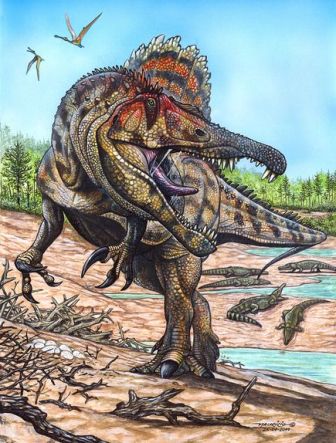
Picture credit: Brazilian National Museum/Elaine Machado.
The artist has depicted this new spinosaur with a sail-like structure running along the back, a feature found in other members of this dinosaur family. There is no fossil evidence to suggest that this particular spinosaur had a sail.
The fragmentary fossils including the tip of the upper jaw, so characteristic of other known spinosaur material were found in the Alcantara Formation on Cajual island which is part of north-eastern Brazil’s Maranhao state. The fossils have been dated to around 98 to 95 million years ago (Cenemanian faunal stage) and the scientists who have been studying this new dinosaur have stated that this new discovery is important as it helps to establish the ancestral line of this geographically dispersed group of theropods.
Alexander Kellner, a Brazilian palaeontologist and one of the researchers who has studied the fossils, stated that this new dinosaur from Brazil, although known from only fragmentary material seems to have a closer affinity to African spinosaurs than to other spinosaurids known from South America. This similarity suggests that the ancestors of the African and Brazilian genera came from the same area before the African and South American continents split as part of the Atlantic ridge formation, sometime between 130 and 110 million years ago.
The Characteristic Snout Tip of a Spinosaur – Oxalaia quilombensis
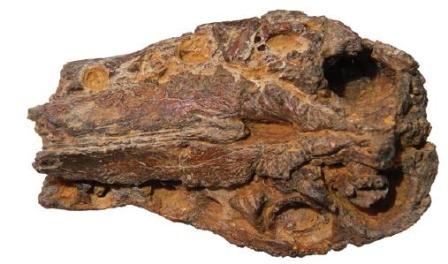
Evidence of Giant Spinosaur?
Picture credit: Kellner et al.
The picture shows the tip of the upper jaw of Oxalaia quilombensis, this the view from underneath (ventral view), the holes along the sides are sockets for teeth. The end of the jaw is to the right of the picture.
The Brazilian scientists hope to be able to find more fossil material from the site, but they have been hampered by the problem of fossil material being rapidly eroded and destroyed once it is exposed. The fossils found so far, are being stored at the Federal University of Rio de Janeiro’s National Museum.
It seems that this particular theropod had two rows of extra teeth on both sides of its mouth, suggesting that it could replace worn or broken teeth. Just like in many other theropods and sharks, as one tooth was lost another was waiting to erupt through the gum line as a replacement. This ensured that these dinosaurs always had a toothy grin, just what is needed when you are an active hunter.
Unfortunately, no limb bones have been found, so this new specimen is unable to add to the debate over whether these large predators were entirely bipedal or facultative quadrupeds (able to walk on all fours if the need arose). The limb proportions of some spinosaurs indicate that their arms were much longer than other large theropods, much larger than tyrannosaurs, allosaurs and abelisaurids. This has led to some interesting and very different interpretations of spinosaurs from model makers – from the graceful and delicate features of the Safari Carnegie Spinosaurus model to the more robust models made by Schleich and CollectA.
To view Everything Dinosaur’s selection of scale Spinosaurus models and other spinosaurids, take a look at this section of the Everything Dinosaur website: CollectA Deluxe Prehistoric Life Models.
The scientific paper: “A new dinosaur (Theropoda, Spinosauridae) from the Cretaceous (Cenomanian) Alcântara Formation, Cajual Island, Brazil” by Alexander W. A. Kellner, Sergio A. K. Azevedo, Elaine B. Machado, Luciana B. De Carvalho and Deise D. R. Henriques published in the Annals of the Brazilian Academy of Sciences.


